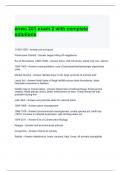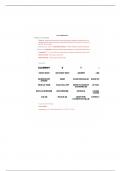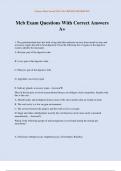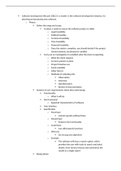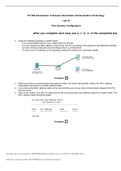Null hypothesis (H0): There’s no effect. This is the one we try to reject
Alternative hypothesis (H1): There is an effect (women are more likely to wear a skirt
than men). If we can reject H0, this is the one that is SUPPORTED by the data, but
not PROVEN
NHST = Null Hypothesis Significance Testing
Level of measurement:
o Categorical
Binary or dichotomous variable
Nominal variable
Ordinal variable
o Continuous
Interval
Ratio
Always report de Standard Deviation (SD = 3.45) if you report the mean (M = 19.22)
If you’re asked to calculate the mode and the mean you can also make a histogram
that visualizes it
Making graphs: When describing a graph (histogram) mention the following:
- Difference between two variables (more/less than)
- CI’s overlap yes or no
- Conclude if statistical difference yes or no
- Always mention that you still need to perform a statistical test to determine the
exact p-value to determine statistical significance
Outliers:
o Observed values that are ‘extreme’ (they don’t represent reality well)
o They may lead to a biased estimate of the mean, particularly when sample sizes
are small.
o The SD gives you an indication of whether there are outliers in the sample
Syntax is done with ‘paste’
To only select one case of a variable go to Data > Select Cases > and choose the
option to only get the data you’re interested in
If they ask to be criticical on the questions, look at the question if the question is
asked clear enough (month/year for example)
Simple scatter Line can be included after the output is generated. Double click the
scatter > elements > fit line at total > linear > no “attach label to line”
Actually always do recode into different variables instead of recode into same
variables
There are different variables that can be computed with compute variable; means,
differences and sums
A normal distribution (bell-shaped) has a Mean = 0 and a SD = 1
Testing assumptions
1) Normality
2) Homogeneity of variances
3) Dependent variable must be interval or ratio
4) Data from different participants need to be independent
Homogeneity: Levene’s test
o Tests if variances in different groups are the same.
o Significant = Variances not equal
o Non-Significant = Variances are equal
, If highter than .05 (5%) then there’s no significant difference, the homogeneity of
variances is met
Normality: Calculate the z-scores for Skewness/kurtosis normal if:
o 95% of z-scores lie between −1.96 and 1.96.
o 99% of z-scores lie between −2.58 and 2.58,
o 99.9% of them lie between −3.29 and 3.29.
- Perform Kolmogorov-Smirnov test Explore > Plots > Normality plots with tests
> Transformed Normal when higer than .05
To visualize the normality in a graph perform Q-Q plot
Check reliability (Cronbach’s alpha) Analyze > Scale > reliability analysis > put
them all into items > statistics > check: item, scale and scale if item deleted >
continue. Output between .7 and .8 = good alpha. Report like: The mean of the scale
was 2.67 (SD = 0.59) and the reliability of the scale was good, α = .85.
Which test to choose for? And how?!!
The T-test is commonly used to examine whether the means of two samples of
scores differ significantly from each other, or whether the mean of a single sample
of scores differs significantly from some pre-established scores.
o One-sample T-test (used when you want to know if the mean of one sample
differs significantly from some specified value “Is the group on average older
than 24?”)
o Independent-samples T-test (used when the scores are of the groups are
unrelated or independent; “Do boys drink more alcohol than girls?")
o Paired-Samples T-test or dependent T-test (used when scores are measured
within members of the same group, so scores are related; “prior/after”)
One-way ANOVA: allows you to determine the significance of the differences among
3 (or more!) groups, rather than just 2.
Follow-up tests:
o Post hoc analysis: You compare all means
o Planned contrast analysis: You do a specific analysis
For each test there’s a different effect size to calculate:
o ANOVA: (Partial) Eta-Squared η2
o Post Hoc: Effect size (cohen’s d)
o Planned contrast: Pearson’s r
Welch One-way ANOVA: The Welch-test results are the ones you report if the
Levene’s test have indicated trouble with homogeneity.
Two-way or factorial ANOVA: allows you to analyze the simultaneous effects of two
(or more) independent variables or factors on some dependent variable.
Interaction effect (two-way or factorial ANOVA)
o Show how the effects of one IV might depend on the effects of another
o Are often more interesting than main effects
Simple effects: with the main analysis you can check whether there IS an interaction
effect Done via SYNTAX
Correlation test
o Correlation analysis: “relationship or assocation”
o Examples correlation tests
Regression analysis
o Regression analysis: if the question contains “predict”
Regression model is good if the individual outcomes deviade a lot from the mean and
deviate low from the regression line
Steps for doing a regression analysis
Chi-square
,o Df 1 means 2 rows, 2 col, DF 2 means 2 rows, 3 col
, Templates for all tests
One-sample T-Test
Analyze > Compare Means > One-Sample T Test.
Cohen’s d
Independent samples T-Test
Analyze > Compare Means > Independent-Samples T Test.
Cohen’s d
Paired-samples / dependent T-Test
Analyze >Compare Means >Paired Samples T test.
One-way ANOVA
Analyze > Compare means > One-way ANOVA: options > Descriptive, homogeneity
of variance test and Welch > Continue
Planned contrasts: Pearson’s r
Post hoc: Cohen’s d
Two-way/factorial ANOVA
Analyze > General Linear Model > Univariate
Simple effects (SPSS Syntax)
Correlation analysis
Analyze > Correlate > Bivariate
Regression analysis
Analyze > Regression > Linear
Chi-square test (crosstab)
Analyze > Descriptive statistics > Cross tab
Odds ratio


